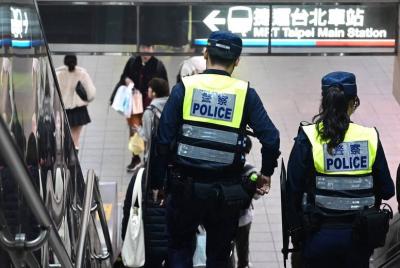Former first lady Wu Shu-jen (吳淑珍), who is paralyzed from the waist down, must be taken to a prison hospital to undergo a fitness evaluation before a decision can be made as to whether she will be incarcerated, Minister of Justice Tseng Yung-fu (曾勇夫) said yesterday.
Speaking at a pre-Lunar New Year holiday news conference, Tseng said the Kaohsiung District Prosecutors’ Office has sent Wu’s medical records to Pei Teh Hospital — the medical facility connected to Taichung Prison — to facilitate the assessment.
“Pei Teh’s management told us that Wu’s ability to deal with daily activities can be assessed only after she is taken to the hospital,” Tseng said.
Asked if the ministry has a timetable for Wu to begin serving her sentence, Tseng said it would respect the judgment of the medical professionals conducting the evaluation and abides by the law in dealing with each case.
Wu and her husband, former president Chen Shui-bian (陳水扁), were each sentenced to a total of 19 years in prison by the Supreme Court last November for taking bribes in a land deal and in relation to a personnel appointment case during Chen’s presidency from 2000 to 2008.
The Taiwan High Court ruled last month that Wu and Chen should each serve 17-and-a-half years.
Chen was moved to Taipei Prison in Taoyuan County on Dec. 2 to begin serving his sentence, after having been held at a detention center since late 2008.
Judicial authorities are still considering how Wu should serve her sentence, given that she has been paralyzed from the waist down since being repeatedly run over by a truck in 1985 and is confined to a wheelchair.
At a separate setting yesterday, a Taichung Prison secretary, Lin Chih-hsiung (林志雄), said that a medical team at Pei Teh Hospital had already undertaken an initial review of Wu’s medical records.
“As Wu’s medical records are extensive, the team has suggested that she be taken to the hospital for an in-person evaluation of her fitness for incarceration,” Lin said, adding that the prison has informed the ministry of the medical team’s advice.

Beijing could eventually see a full amphibious invasion of Taiwan as the only "prudent" way to bring about unification, the US Department of Defense said in a newly released annual report to Congress. The Pentagon's "Annual Report to Congress: Military and Security Developments Involving the People's Republic of China 2025," was in many ways similar to last year’s report but reorganized the analysis of the options China has to take over Taiwan. Generally, according to the report, Chinese leaders view the People's Liberation Army's (PLA) capabilities for a Taiwan campaign as improving, but they remain uncertain about its readiness to successfully seize

Taiwan is getting a day off on Christmas for the first time in 25 years. The change comes after opposition parties passed a law earlier this year to add or restore five public holidays, including Constitution Day, which falls on today, Dec. 25. The day marks the 1947 adoption of the constitution of the Republic of China, as the government in Taipei is formally known. Back then the Chinese Nationalist Party (KMT) governed China from Nanjing. When the KMT, now an opposition party in Taiwan, passed the legislation on holidays, it said that they would help “commemorate the history of national development.” That

Taiwan has overtaken South Korea this year in per capita income for the first time in 23 years, IMF data showed. Per capita income is a nation’s GDP divided by the total population, used to compare average wealth levels across countries. Taiwan also beat Japan this year on per capita income, after surpassing it for the first time last year, US magazine Newsweek reported yesterday. Across Asia, Taiwan ranked fourth for per capita income at US$37,827 this year due to sustained economic growth, the report said. In the top three spots were Singapore, Macau and Hong Kong, it said. South

Police today said they are stepping up patrols throughout the Taipei MRT system, after a social media user threatened to detonate a bomb at an unspecified station this afternoon. Although they strongly believe the threat to be unsubstantiated, Taipei Metro police and the Railway Police Bureau still said that security and patrols would be heightened through the system. Many copycat messages have been posted since Friday’s stabbing attacks at Taipei Main Station and near Zhongshan MRT Station that left three dead and 11 injured, police said. Last night, a Threads user in a post said they would detonate a bomb on the Taipei